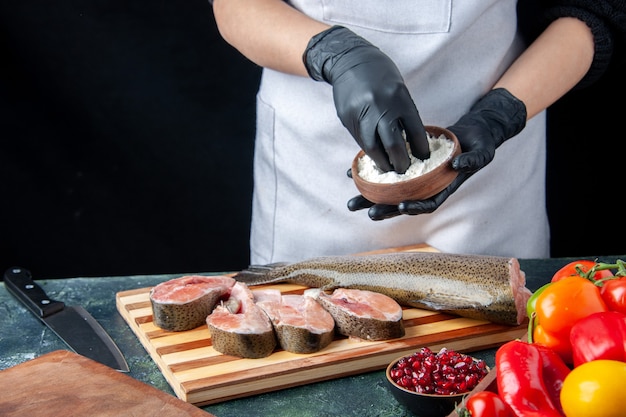There's a reason filet mignon is considered the king of steaks. It's the epitome of luxurious dining, a tender, juicy masterpiece that melts in your mouth. But let's be real, mastering the art of cooking a perfect filet mignon can feel intimidating. You've got searing, resting, temperature concerns, and oh, that daunting internal temperature gauge. It's enough to make you consider ordering takeout. But fear not, my fellow foodies, because today, I'm going to break down the secrets of cooking a filet mignon that will make you feel like a culinary rockstar. You'll be surprised at how simple it can be once you understand the process.
Part 1: Choosing the Perfect Filet Mignon

The journey to the perfect filet mignon begins with choosing the right piece of meat. It's like building a house - you need a solid foundation for your culinary masterpiece. Now, I'm not talking about just any old filet, I'm talking about a cut that will send your taste buds into a frenzy.
Understanding the Cut
Filet mignon, also known as the tenderloin, is the most tender cut of beef. It comes from the muscle that runs along the spine of the cow, right underneath the loin. It's lean, with very little marbling, which makes it naturally delicate and melts in your mouth. It's often sold as a center-cut filet mignon, which is the most tender part of the tenderloin.
Graded for Quality
When you're at the butcher counter, you'll see filet mignon graded by the USDA. This grading system categorizes beef based on its quality, marbling, and tenderness. The four grades you'll find are:
- Select: The most common grade and most affordable, but it's leaner and has less marbling. This means it might be a bit drier and less flavorful.
- Choice: This is the most popular grade and offers a good balance of price and quality. It's tender, juicy, and has a good amount of marbling for flavor.
- Prime: prime filet mignon is the king of the hill, considered the top tier. It's the most expensive, but it's also the most flavorful and tender. It has the most marbling, resulting in a rich and juicy steak.
- Select: This grade is reserved for beef that doesn't meet the requirements for Prime, Choice, or Select. It's typically only available for commercial use.
For a truly exceptional filet mignon experience, go for a Prime cut. But if your budget is a bit tighter, Choice is a great option that won't disappoint.
What to Look For
Once you've chosen your grade, it's time to find the perfect piece of filet mignon. Look for a piece that's a vibrant red color, with even marbling throughout. It should also feel firm to the touch, not squishy or soft. This indicates the meat is fresh and of good quality.
- Avoid any cuts that are discoloured, have a strong odour, or feel slimy. This could be a sign of spoilage.
- Choose a filet that’s a bit larger than you think you'll need. You can always trim it down later. This is better than ending up with a steak that's too small.
Part 2: Prepping for Perfection

You've got your filet mignon, now it's time to get it ready for its culinary debut. Just like a star getting ready for the red carpet, you want to make sure your steak looks and tastes its absolute best.
1. Room Temperature
Let your filet mignon sit at room temperature for about 30 minutes before cooking. This helps it cook more evenly and prevents a shock to the meat from going straight from the refrigerator to the hot pan. Just like you wouldn't want to jump into a cold pool, your steak will cook better if it’s not cold.
2. Pat It Dry
Pat the filet mignon dry with paper towels. This will help it sear better and prevent steam from building up during cooking. You want that beautiful, crispy crust, not a soggy mess.
3. Seasoning Up
Now comes the fun part: seasoning! This is your chance to unleash your inner chef and create a flavour profile that complements the delicate taste of the filet mignon. I'm a fan of a simple combination of salt, pepper, and garlic powder. But if you want to get fancy, try experimenting with herbs and spices like rosemary, thyme, or even a touch of paprika. Remember, it's your steak, so season it to your liking!
A quick tip: season liberally, but don't overdo it. You want to enhance the natural flavour of the meat, not drown it out.
Part 3: The Art of Searing

Searing is the most dramatic part of the cooking process - the moment where your filet mignon transforms into a culinary masterpiece. It's all about creating that beautiful, crispy crust that locks in the juices and gives the steak an irresistible texture.
Choosing Your Weapon
For searing, you can use a cast iron skillet, a grill pan, or even a grill. The key is that your chosen tool needs to get super hot. I personally prefer to use a cast iron skillet because it distributes heat evenly and gets ridiculously hot, but you can use whatever you have on hand.
The Heat is On
You want your skillet or grill pan smoking hot. You can test it by sprinkling a few drops of water on the surface. If the water sizzles and evaporates instantly, you're good to go.
Time to Get Searin’
Place the filet mignon in the hot pan and let it cook undisturbed for 2-3 minutes per side. Don’t touch it! The goal is to get a nice, even crust on all sides. You'll know it's ready when it has a beautiful brown colour and a crispy texture.
Part 4: Time for the Oven
You've got that amazing crust, now it's time to finish cooking the filet mignon to your desired level of doneness. This is where the oven comes in, allowing for a more gentle and controlled cooking process.
Preheat Perfection
Preheat your oven to 400°F (200°C). A preheated oven ensures that the steak cooks evenly and doesn't get cold spots. This is crucial for achieving a perfectly cooked filet mignon.
Into the Oven
Transfer the filet mignon from the skillet to a baking sheet. This allows for even heat distribution and prevents any potential splatters in your oven. Place the baking sheet in the preheated oven.
cooking time
Here's where you need to pay attention to your desired level of doneness. I'm going to give you a general guide, but remember, you know your taste buds best!
| Doneness | Internal Temperature | Approximate Cooking Time |
|---|---|---|
| Rare | 125°F (52°C) | 5-6 minutes |
| Medium-Rare | 130°F (54°C) | 7-8 minutes |
| Medium | 140°F (60°C) | 10-12 minutes |
| Medium-Well | 150°F (66°C) | 14-16 minutes |
| Well-Done | 160°F (71°C) | 18-20 minutes |
Use a meat thermometer to check the internal temperature of the steak. This is the most accurate way to ensure your filet mignon is cooked to your liking. Once it reaches your desired temperature, remove it from the oven and let it rest.
Part 5: Resting is Key
The resting period is crucial. It's like giving your steak a chance to relax and redistribute its juices. I know it can be tempting to dive in right away, but trust me on this one. This is a vital step in ensuring a tender and juicy filet mignon.
The Resting Period
Let the filet mignon rest for at least 10 minutes before slicing. Cover it loosely with aluminum foil to keep it warm. This allows the juices to redistribute throughout the meat, resulting in a more tender and flavorful steak.
Part 6: The Moment of Truth
The time has come to unleash your masterpiece! Get ready to savor those amazing flavours and textures. It's the culmination of all your hard work and attention to detail.
Slicing with Care
Use a sharp knife to slice the filet mignon against the grain. This helps to prevent the steak from being tough. This ensures that each bite is tender and melts in your mouth.
Presentation Matters
Now, you can get creative with your plating. A simple bed of mashed potatoes or roasted vegetables will elevate your steak to new heights. And don't forget a dollop of butter or a drizzle of sauce. A beautifully presented steak is a feast for the eyes as well as the taste buds.
Part 7: Sides and Sauces
Let's talk sides and sauces, because a filet mignon deserves to be surrounded by delicious companions. Think of it as creating a symphony of flavours, where each element enhances the other.
Sides That Shine
You can never go wrong with classic sides like mashed potatoes, roasted vegetables, or a green salad. They provide a comforting and familiar complement to the rich and decadent filet mignon. But if you want to elevate your game, try something a bit fancier like creamed spinach, asparagus with hollandaise sauce, or a gratin dauphinois. These additions will add complexity and sophistication to your meal.
Sauce, Please
I love a good red wine sauce, but you can also go with a classic Béarnaise or a creamy peppercorn sauce. They provide a rich and savory contrast to the tender meat. You can even get creative and try a balsamic glaze, a chimichurri sauce, or a lemon herb butter. The possibilities are endless, and you can customize your sauce to complement your personal taste.
Part 8: Don’t Forget the Wine!
No filet mignon experience is complete without a glass of wine. It's a perfect marriage of flavour and aroma that takes your dining experience to another level. You’ve got to complement those bold flavours, and what better way than with a delicious wine?
Red Wine Pairing
For a medium-rare to medium filet mignon, I recommend a full-bodied red wine like Cabernet Sauvignon, Merlot, or Zinfandel. These wines have enough tannins and complexity to stand up to the richness of the steak, creating a harmonious balance of flavors.
White Wine Pairing
If you prefer a lighter steak, you can opt for a white wine like Chardonnay or Sauvignon Blanc. These wines have a refreshing acidity that will cut through the richness of the steak, making for a lighter and brighter pairing.
FAQs
1. Can I cook a filet mignon from frozen?
I wouldn't recommend it. Frozen steak can be tough and unevenly cooked. It's best to thaw it in the refrigerator overnight before cooking. This allows the meat to thaw slowly and evenly, resulting in a more tender and flavorful steak.
2. How do I know when the filet mignon is done?
The best way to check for doneness is to use a meat thermometer. It's the most accurate way to ensure your steak is cooked to your liking. But if you don't have one, you can use the finger test. Press the center of the steak. If it feels firm, it's well-done. If it feels soft, it's rare. However, this method is not as reliable as using a thermometer.
3. What happens if I overcook the filet mignon?
Overcooked filet mignon will be dry and tough. It's best to err on the side of undercooked, as you can always cook it a little longer if necessary. A good rule of thumb is to start with a shorter cooking time and adjust it based on the internal temperature.
4. Can I cook a filet mignon in a pan without an oven?
Yes, you can cook a filet mignon in a pan on the stovetop. Just make sure the pan is super hot and cook the steak for 2-3 minutes per side. This will create a beautiful crust while maintaining a tender and juicy center.
5. What’s the best way to store leftovers?
Wrap the leftover filet mignon tightly in plastic wrap or aluminum foil and store it in the refrigerator for up to 3 days. You can also freeze it for up to 3 months. This will preserve the flavor and texture of the steak for later enjoyment.
Now, go forth and conquer the filet mignon! You've got all the tools and knowledge you need to impress your family and friends. And remember, cooking is a journey, not a destination. So relax, have fun, and enjoy the process!
Everyone is watching

Corn on the Cob: The Ultimate Guide to Perfectly Cooked Ears
Healthy MealsAh, corn on the cob. Just the name evokes images of sunny days, barbecues, and that sweet, juicy flavour that ...

Perfect Pork Roast Oven Cooking Time: A Guide to Delicious Results
Healthy MealsThere's something truly satisfying about a perfectly roasted pork. The aroma alone is enough to make your mout...

Ham Cooking Time: How Long to Bake, Smoke, or Boil a Delicious Ham
Healthy MealsAh, ham. It's a classic, isn't it? A real crowd-pleaser, especially around holidays. And when done right, it'...

Scallops: The Ultimate Guide to Perfect Cooking
Healthy MealsAh, scallops. Those delicate, sweet, and utterly delicious morsels of the sea. They hold a special place in my...

Spaghetti Squash: The Ultimate Guide to Cooking and Serving
Healthy MealsRemember that time you saw spaghetti squash at the supermarket, looking all bumpy and strange, and thought, "W...
